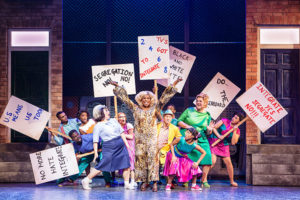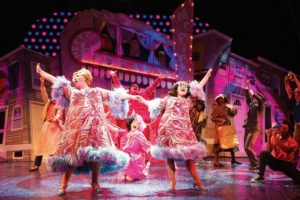 (4 / 5)
(4 / 5)
If you’ve toyed with the idea of seeing Hairspray on stage but doubted whether anyone could top Ricki Lake’s original 1988 portrayal of Tracy – or indeed Nikki Blonsky’s 2007 film version, you really needn’t worry.
The new stage version of Hairpray brought to you by producers Mark Goucher, Matthew Gale and Laurence Myers will delight new and old fans from start to finish.
The show hasn’t lost an ounce of its popularity, having first swept the board at the Tony Awards on Broadway in 2002 and the more recent film version introducing a new generation of fans to the musical and original film.
Set in 1960s Baltimore, Tracy Turnblad dreams of a starring role as one of the teenage dancers on the popular Corny Collins show – a cheeseball TV format of young beautiful things dancing and miming to the latest pop / rock n roll records.
Already at a disadvantage due to her shape, she encounters the realities of colour segregation rife in Baltimore and the US at the time. Only white teenagers were allowed to dance on the show, apart from ‘Negro Day’ every other Friday.
Based on real events with the real ‘Buddy Deane Show’, on which Hairspray was based, the story sees Tracy lead a group of friends to storm the TV studio and force the live broadcasting of integrated dancing, leading a protest against colour segregation and challenging preconceived ideas about women of shape at the same time.
The show is perfectly aided by a riot of technicolour staging and costume courtesy of TAKIS, while Drew McOnie’s superb vintage choreography will have your heart fluttering and your foot tapping.
But the story reminds us that for all the iconic fashions, bubble-gum scented nostalgia and fondness for the golden era of pop and rock and roll, black Americans were denied basic civil rights across America.
Such was the power and divisiveness of segregation, we see ‘seemingly nice’ young all-American kids suddenly spewing hatred and vitriol when the status quo is challenged. Underneath the petticoats and the chucks and the varsity jackets and polite manners, there is suddenly spite and anger.

Hairspray is gently subversive, poking fun at the idiocy, prejudice and fear at the heart of white America. What’s all the more cutting is the reminder that while the 60s may seem far away, the lurking presence of racism is rearing it’s ugly head again in the US.
Two years ago I used Hairspray (the movie) as a vehicle to talk about civil rights and race in America in the 60s with my little girl. Suddenly, it’s time to return to that ugly, awkward conversation. We’re at a crossroads once again – because ‘nice guys’ in middle America are waving around swastika flags and white hoods.
It’s not too hard to believe that the ‘nice polite white kids’ at the Corny Collins dance might have been the same kids lining up to shout abuse at kids entering the first integrated schools or kicking off at the lunch counters they thought were their domain when black protesters sat in ‘their place’.
So as an audience we laugh when Penny Pingleton’s Mum screams when she finds her daughter in bed with a black boy and shrieks ‘But what about the neighbours….the house prices!?’, when her deep-rooted instinct is to flinch/cower when Seaweed gives her a hug or when others gasp with horror as Tracy Turnblad admits she WOULD swim in an integrated swimming pool.
In some shape or form, we’ve all encountered the tropes and the stereotypes surrounding integration and mixed heritage relationships. We’ve rolled our eyes at the staggering lack of awareness even the nicest of people have, just like those kids at the hop in the ‘Nicest kids in town’ song in the first act.

I was overjoyed to once again see Layton Williams (in the role of Seaweed) at the WMC, who previously slayed in the role of Angel Dumott Schunard in RENT earlier this year. I’ve decided it is utterly impossible to take your eyes off him whenever he is on stage. Former X Factor contestant Brenda Edwards was spellbinding as Motormouth Maybelle, with vocals that shook the rafters and I loved Annalise Liard-Bailey’s squeaky/dorky portrayal of Penny. Ensemble cast member Graham Macduff was also hilarious in all his guises.
As anyone who’s seen the 2007 film adaptation of Hairspray will tell you – you can never unsee the sight of John Travolta in a dress, but Matt Rixon and Norman Pace (of ‘Hale and Pace’) had a wonderful on-stage presence together and clearly enjoyed each other’s company
Hairspray recognises the ridiculousness of racism, blinds it with sequins and deafens these ugly faults with a soundtrack of rock n roll, pop, cha-cha-cha and motown.
It calls racism out for what it is and still dares you to believe that the future will be different. It’s hammy, it’s cheesy, it’s sweet and it’s a glitter bomb of cherry-cola scented joy.
